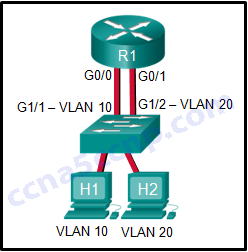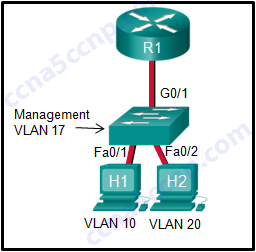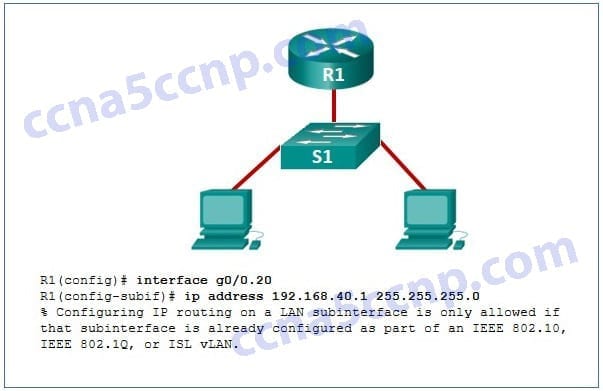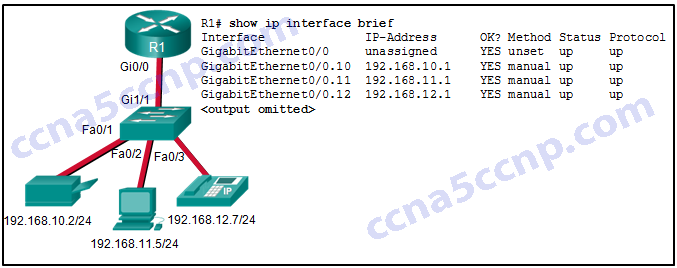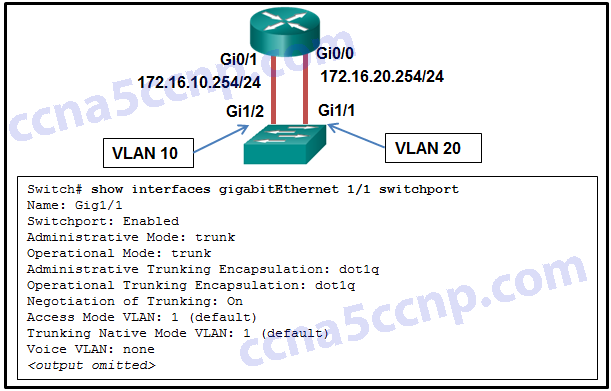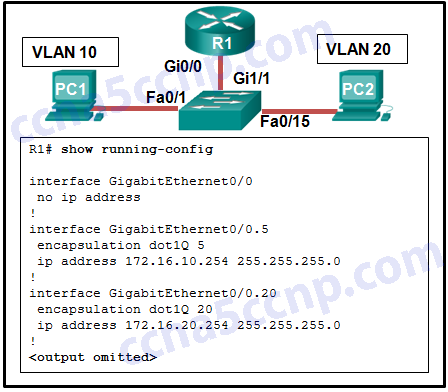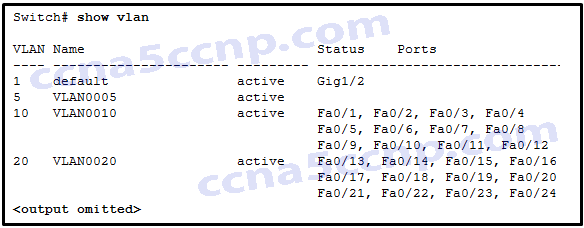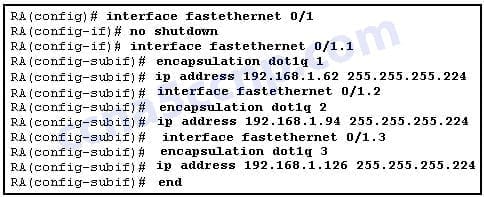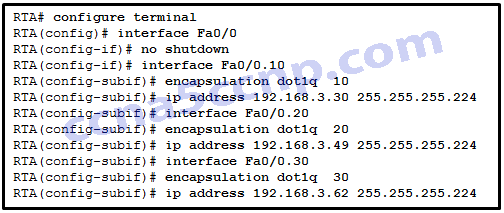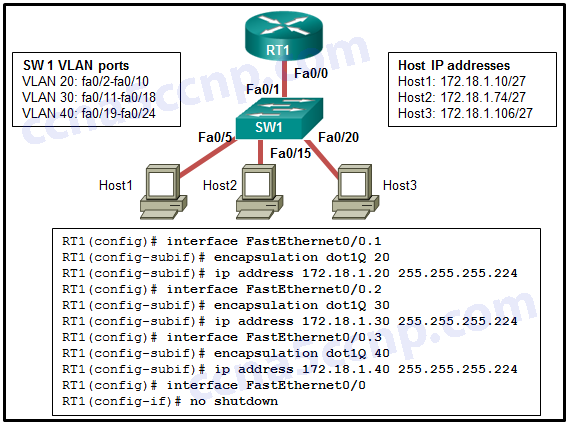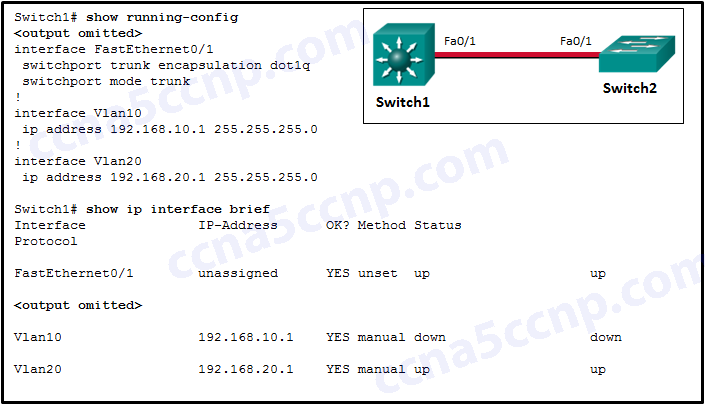Last Updated on April 3, 2018 by Admin
CCNA2 Chapter 5 Exam Answer 2016 v5.03
From year to year, Cisco has updated many versions with difference questions. The latest version is version 6.0 in 2018. What is your version? It depends on your instructor creating your class. We recommend you to go thought all version if you are not clear. While you take online test with netacad.com, You may get random questions from all version. Each version have 1 to 10 different questions or more. After you review all questions, You should practice with our online test system by go to "Online Test" link below.
| Version 5.02 | Version 5.03 | Version 6.0 | Online Assessment |
| Chapter 5 Exam | Chapter 5 Exam | Chapter 5 Exam | Online Test |
| Next Chapter | |||
| Chapter 6 Exam | Chapter 6 Exam | Chapter 6 Exam | Online Test |
| Lab Activities | |||
| 5.2.1.4 Packet Tracer – Configuring SSH | |||
| 5.2.2.7 Packet Tracer – Configuring Switch Port Security | |||
| 5.2.2.8 Packet Tracer – Troubleshooting Switch Port Security | |||
| 5.3.1.2 Packet Tracer – Skills Integration Challenge | |||
-
What is a disadvantage of using router-on-a-stick inter-VLAN routing?
- does not support VLAN-tagged packets
- requires the use of more physical interfaces than legacy inter-VLAN routing
- does not scale well beyond 50 VLANs
- requires the use of multiple router interfaces configured to operate as access links
-
How is traffic routed between multiple VLANs on a multilayer switch?
- Traffic is routed via physical interfaces.
- Traffic is routed via internal VLAN interfaces.
- Traffic is broadcast out all physical interfaces.
- Traffic is routed via subinterfaces.
-
Refer to the exhibit. In this network design, which connection or connections if any, add the VLAN ID number if host H1 sends information to host H2?
- no link
- from H1 to the switch
- from the switch to G0/0 on the router
- from G0/1 on the router to G1/2 on the switch
- from the switch to H2
-
What is a characteristic of legacy inter-VLAN routing?
- Only one VLAN can be used in the topology.
- The router requires one Ethernet link for each VLAN.
- The user VLAN must be the same ID number as the management VLAN.
- Inter-VLAN routing must be performed on a switch instead of a router.
-
Refer to the exhibit. A network administrator needs to configure router-on-a-stick for the networks that are shown. How many subinterfaces will have to be created on the router if each VLAN that is shown is to be routed and each VLAN has its own subinterface?
- 1
- 2
- 3
- 4
- 5
-
Refer to the exhibit. In what switch mode should port G0/1 be assigned if Cisco best practices are being used?
- access
- trunk
- native
- auto
-
Refer to the exhibit. What is the problem with this configuration, based on the output of the router?
- The subnet mask is wrong.
- There is no subinterface for the administrative VLAN.
- The subinterface number does not match the third octet in the IPv4 address.
- The encapsulation has not been configured on the subinterface.
-
Refer to the exhibit. Communication between the VLANs is not occurring. What could be the issue?
- The wrong port on the router has been used.
- The Gi1/1 switch port is not in trunking mode.
- A duplex issue exists between the switch and the router.
- Default gateways have not been configured for each VLAN.
-
Refer to the exhibit. A network administrator is verifying the configuration of inter-VLAN routing. Users complain that PCs on different VLANs cannot communicate. Based on the output, what are two configuration errors on switch interface Gi1/1? (Choose two.)
- Gi1/1 is in the default VLAN.
- Voice VLAN is not assigned to Gi1/1.
- Gi1/1 is configured as trunk mode.
- Negotiation of trunking is turned on on Gi1/1.
- The trunking encapsulation protocol is configured wrong.
-
Refer to the exhibit. A network administrator is verifying the configuration of inter-VLAN routing. Users complain that PC2 cannot communicate with PC1. Based on the output, what is the possible cause of the problem?
- Gi0/0 is not configured as a trunk port.
- The command interface GigabitEthernet0/0.5 was entered incorrectly.
- There is no IP address configured on the interface Gi0/0.
- The no shutdown command is not entered on subinterfaces.
- The encapsulation dot1Q 5 command contains the wrong VLAN.
-
Refer to the exhibit. A network administrator is verifying the configuration of inter-VLAN routing. Based on the partial output that is displayed by the use of the show vlan command, which conclusion can be drawn for the Gi1/1 interface?
- It is shut down.
- It belongs to the default VLAN.
- It is configured as trunk mode.
- It is not connected to any device.
-
Inter-VLAN communication is not occurring in a particular building of a school. Which two commands could the network administrator use to verify that inter-VLAN communication was working properly between a router and a Layer 2 switch when the router-on-a-stick design method is implemented? (Choose two.)
- From the router, issue the show ip route command.
- From the router, issue the show interfaces trunk command.
- From the router, issue the show interfaces interface command.
- From the switch, issue the show interfaces trunk command.
- From the switch, issue the show interfaces interface command.
-
How are IP addressing designs affected by VLAN implementations?
- VLANs do not support VLSM.
- VLANs do not use a broadcast address.
- Each VLAN must have a different network number.
- Each VLAN must have a different subnet mask.
-
While configuring inter-VLAN routing on a multilayer switch, a network administrator issues the no switchport command on an interface that is connected to another switch. What is the purpose of this command?
- to create a routed port for a single network
- to provide a static trunk link
- to create a switched virtual interface
- to provide an access link that tags VLAN traffic
-
What is a disadvantage of using multilayer switches for inter-VLAN routing?
- Multilayer switches have higher latency for Layer 3 routing.
- Multilayer switches are more expensive than router-on-a-stick implementations.
- Spanning tree must be disabled in order to implement routing on a multilayer switch.
- Multilayer switches are limited to using trunk links for Layer 3 routing.
-
What is a characteristic of a routed port on a Layer 3 switch?
- It supports trunking.
- It is not assigned to a VLAN.
- It is commonly used as a WAN link.
- It cannot have an IP address assigned to it.
-
An administrator is attempting to configure a static route on a Cisco 2960 series switch. After the administrator types the command ip route 0.0.0.0 0.0.0.0 10.1.1.1, an error message appears stating that the command is not recognized. What must the administrator do so that this command is accepted?
- Enter the command no switchport.
- Enter the command ipv6 unicast-routing.
- Enter the command ip route 0.0.0.0 0.0.0.0. vlan 10.
- Enter the command sdm prefer lanbase-routing and reload.
-
Which statement describes a disadvantage of using router subinterfaces for inter-VLAN routing?
- It is more expensive than using individual router interfaces.
- Routed traffic must contend for bandwidth on a single router interface.
- Trunking cannot be used to connect the router to the switch.
- All untagged traffic is dropped.
-
Refer to the exhibit. Router RA receives a packet with a source address of 192.168.1.35 and a destination address of 192.168.1.85. What will the router do with this packet?
- The router will drop the packet.
- The router will forward the packet out interface FastEthernet 0/1.1.
- The router will forward the packet out interface FastEthernet 0/1.2.
- The router will forward the packet out interface FastEthernet 0/1.3.
- The router will forward the packet out interface FastEthernet 0/1.2 and interface FastEthernet 0/1.3.
-
Refer to the exhibit. After attempting to enter the configuration that is shown in router RTA, an administrator receives an error and users on VLAN 20 report that they are unable to reach users on VLAN 30. What is causing the problem?
- Dot1q does not support subinterfaces.
- There is no address on Fa0/0 to use as a default gateway.
- RTA is using the same subnet for VLAN 20 and VLAN 30.
- The no shutdown command should have been issued on Fa0/0.20 and Fa0/0.30.
-
Refer to the exhibit. A network administrator is configuring RT1 for inter-VLAN routing. The switch is configured correctly and is functional. Host1, Host2, and Host3 cannot communicate with each other. Based on the router configuration, what is causing the problem?
- Interface Fa0/0 is missing IP address configuration information.
- IP addresses on the subinterfaces are incorrectly matched to the VLANs.
- Each subinterface of Fa0/0 needs separate no shutdown commands.
- Routers do not support 802.1Q encapsulation on subinterfaces.
-
What condition is required to enable Layer 3 switching?
- The Layer 3 switch must have IP routing enabled.
- All participating switches must have unique VLAN numbers.
- All routed subnets must be on the same VLAN.
- Inter-VLAN portions of Layer 3 switching must use router-on-a-stick.
-
Refer to the exhibit. Which command can the administrator issue to change the VLAN10 status to up?
- Switch1(config)# interface vlan 10
Switch1(config-if)# no shutdown - Switch1(config)# interface vlan 10
Switch1(config-if)# ip address 192.168.10.1 255.255.255.0 - Switch1(config)# interface vlan 10
Switch1(config-if)# ip address 192.168.10.1 255.255.255.0
Switch1(config-if)# no shutdown - Switch1(config)# vlan 10
Switch1(config-vlan)# exit
- Switch1(config)# interface vlan 10
-
Fill in the blank. Do not use abbreviations.
A network engineer is troubleshooting the configuration of new VLANs on a network. Which command is used to display the list of VLANs that exists on the switch? show vlan
-
Match the inter-VLAN routing method to the corresponding characteristic. (Not all options are used.)
- Question
- Answer
-
Open the PT Activity. Perform the tasks in the activity instructions and then answer the question.
Fill in the blank. Do not use abbreviations.
Which command is missing on the Layer 3 switch to restore the full connectivity between PC1 and the web server? (Note that typing no shutdown will not fix this problem.) ip address 192.168.20.1 255.255.255.0
From year to year, Cisco has updated many versions with difference questions. The latest version is version 6.0 in 2018. What is your version? It depends on your instructor creating your class. We recommend you to go thought all version if you are not clear. While you take online test with netacad.com, You may get random questions from all version. Each version have 1 to 10 different questions or more. After you review all questions, You should practice with our online test system by go to "Online Test" link below.
| Version 5.02 | Version 5.03 | Version 6.0 | Online Assessment |
| Chapter 5 Exam | Chapter 5 Exam | Chapter 5 Exam | Online Test |
| Next Chapter | |||
| Chapter 6 Exam | Chapter 6 Exam | Chapter 6 Exam | Online Test |
| Lab Activities | |||
| 5.2.1.4 Packet Tracer – Configuring SSH | |||
| 5.2.2.7 Packet Tracer – Configuring Switch Port Security | |||
| 5.2.2.8 Packet Tracer – Troubleshooting Switch Port Security | |||
| 5.3.1.2 Packet Tracer – Skills Integration Challenge | |||
